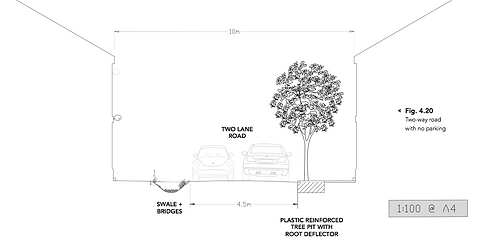
This thesis looks at how British residential streets could evolve in relation to mobility, climate, and social capital (community etc.) changes.
This research is relevant for cities and municipalities who want to develop more sustainable, sociable, and valuable streets. Traditional mobility models are set to change, and this thesis examines these potential changes and demonstrates that older streets and estates needn’t be demolished but can be retrofitted, ultimately improving the wellbeing and sustainability of an area without substantial redevelopment.
What my thesis looks at?
• Electric and autonomous mobility changes
• History and design of chosen residential street types
• Climate change and UHI effects in cities
• GI and biodiversity issues
• Ageing demographics and related health concerns
• Pollution and associated risks
• Walkability
• Social capital and social connections
• Ideas of neighbourhood and community
• Retrofit ideas
9 MONTHS
160 PAGES
27,000 WORDS
With responses from:
Robert Llewellyn
Fully Charged host and former Scrapheap Challenge presenter
Michèl Annink
Senior Director, Mobility Services & Customer Journeys at NEVS (formerly SAAB)
Gijs Van der Poel
Sustainable Mobility Consultant at Over Morgen
Björn Siesjö
Municipal City Architect of Gothenburg, Sweden
Jeff Speck
Author of The Walkable City, and ‘America’s foremost expert on walkability’
Introduction Extract —
2016 was the world’s hottest year on record and, according to analysis by NASA, NOAA and the Meteorological Office, 16 of the 17 warmest years on record have occurred since 2001 (Hawkins, 2017). Atmospheric CO2 concentrations have increased from ~290 ppm (parts per million) at the start of the twentieth century, to ~400 ppm in 2016, and scientists believe that, based on a range of plausible emission scenarios, our Earth is headed for at least a 2 ̊C - 6 ̊C rise in temperature by the end of the 21st century (Keenan et al., 2016; Sustrans et al., 2009:15; Riebeek, 2010).
In 50 years, peak summer temperatures in London are predicted to be 6.5°C
higher than they are today. By 2100, they could be around 10.5°C higher.
— David Symons (WSP | Parsons Brinckerhoff, 2017:9)
‘Global warming is the greatest security threat of the 21st century’. ‘The impacts of climate change were factors in the conflicts driving a current crisis of migration into Europe, having been linked to the Arab Spring, the war in Syria and the Boko Haram terrorist insurgency.’ ‘A UK foreign office report made a stark assessment of the dangers posed by unchecked global warming, including very large risks to global food security, increased risk of terrorism as states fail, and unprecedented migration that would overwhelm international assistance“ (Carrington, 2016).
Countries are going to pay for climate change one way or another. The best way to pay for it is by tackling the root causes of climate change and cutting greenhouse gas emissions. If we do not, the national security impacts will be increasingly costly and challenging.
— Brig Cheney (Carrington, 2016).
Sample Images —






More details available upon request.


